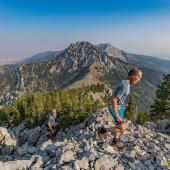Community Caretakers
Gallatin County Search-and-Rescue.
A trip into the backcountry can go south real quick. Whether you roll an ankle and tumble down a scree field, get lost in a sudden snowstorm, or drink from the wrong stream and surrender your fluids to the soil, you won’t be walking out of the woods anytime soon, if ever. Luckily for the residents of Gallatin County, there’s a team of highly-trained experts who will come get you and bring you home, by any means necessary. Here’s a rundown of this backcountry safety net—both its origins and an actual rescue—from members of our local search-and-rescue squad.
Half-Century of Help
The term “sheriff’s posse” conjures images of late-night manhunts for horse thieves and bank robbers. In Gallatin County, the reality is almost as dramatic, and often more so. Formed in 1958 by a group of farmers, ranchers, and businessmen to assist the Sheriff’s Office, the Posse is now part of Search-and-Rescue (SAR). Almost everyone interested in SAR starts on the Posse for training and teamwork development, with some people going on to more specialized groups as their interests and skills evolve. The Posse is made up of three dozen men and women, from building contractors to climbing instructors, but a core group keeps it going. There is inevitable attrition when the 3am let’s-head-out-in-a-blizzard calls come in. Many calls are to rescue competent locals who had a bad day—it is truly the community helping itself.
Before 1985, the Gallatin County Posse performed all SAR work in the area. Every few years, there would be an incident that required more expertise than the Posse had available, and the sheriff would call on local experts in backcountry travel for help.
In 1981, there was an ice-climbing accident up Hyalite Canyon that the ambulance crews couldn’t reach. The Posse was made up of mostly horsemen and they didn’t have the equipment or experience to perform the rescue, so local climbers were called in. Afterward, the sheriff and the climbing groups set up a phone-tree for future incidents.

In 1985, two brothers were killed in an avalanche while skiing on Mt. Ellis, in an area that the Posse again wasn’t able to reach quickly. They reached out to some experienced snowmobilers and backcountry skiers in the community, and many of the top skiers and riders volunteered for what turned out to be a week-long search, before it was called off until spring. The searchers went back to the area periodically, but the bodies weren't found until the snow melted in early summer.
The volunteers worked in an ad-hoc fashion and everyone could see the potential flaws in the lack of organization. Afterward, the sheriff wanted a team of experienced people who could go in quickly and do basic SAR once they reached an area; a swift response was critical to the victim’s survival.
The following Memorial Day, a father fell asleep while driving down Gallatin Canyon and the car, with two kids in it, ended up submerged in the river; the bodies came loose and were not recovered right away. At that point, there were five total bodies unaccounted for in the county, and the sheriff was responsible for finding all of them, including the three in the river. He called an experienced kayaker, who organized searches of the river, but it still took several months before the three bodies were found.
Those two events drove the organization of several groups of experienced outdoors people to help the Posse in searches. The focus was on safety and developing an incident-command structure that would allow rescuers to stay safe during a search. The following year, a mill levy was approved for SAR, the first one in the state; it paid for operations, equipment, and training. —DEBORAH MCATEE
Tale of Two Counties
BEEP. BEEEEP. BEEP. BEEEEP. All search and rescue calls begin with the shrill sound of a pager’s alarm. 911 callout: mutual aid. Park Cty., Granite Peak. Injured climber near summit. HELO ALL CALL.
I’m driving south on Hwy. 89 and talking with another (SAR) coordinator when I realize that I’m moments away from the Park County SAR cache. As we’re talking, another SAR callout in Gallatin County is initiated. We decide that I’ll coordinate the Park County call and my partner will stay in Gallatin and we’ll be in touch as details emerge.
As I arrive at the cache, a Bell 407 helicopter is touching down. The plan is to put a Park County Sheriff, who is also a medic, on board to go scout the scene as a second 911 call has been initiated near the base of Granite Peak for a possible heart attack. While they’re looking for the cardiac patient, they can survey the scene for the alpine rescue that will take place near Granite’s summit.
I’ll rendezvous with some Gallatin County heli-team members at the cache as they will be driving over and flying over in the A-Star. The AS350 is the ultimate flying machine for high-altitude missions, a workhorse ideal for the operation underway. As coordinator, I’ll deal with all logistics at the cache and work through potential issues or coordination with other emergency resources.
The patient is a young male climber who has fallen 40-60 feet. The reporting party indicated that he has head trauma and is breathing. This is about as much information as we might get on a given callout; often there’s less information or it’s less accurate. My teammates will perform a dangerous short-haul rescue with high consequences, but it’s deemed our best option given the circumstances. During a short-haul rescue, the rescuer hangs below the helicopter on a 150-foot line and is “inserted” on scene.

Within three hours of the 911 mutual-aid callout, the team is in the process of extricating the patient to an air ambulance that will transport him to definitive care. A few moments prior, the 407 helicopter found the cardiac patient who was transported to lower elevation and a waiting ambulance. The Bell 407 then remained on-scene as backup to the A-Star executing the short-haul operation. The patient was transferred from Billings to Seattle, but sadly passed away after multiple surgeries and a valiant effort by many.
Unfortunately, sometimes our stories don’t have happy endings. —TODD THESING














